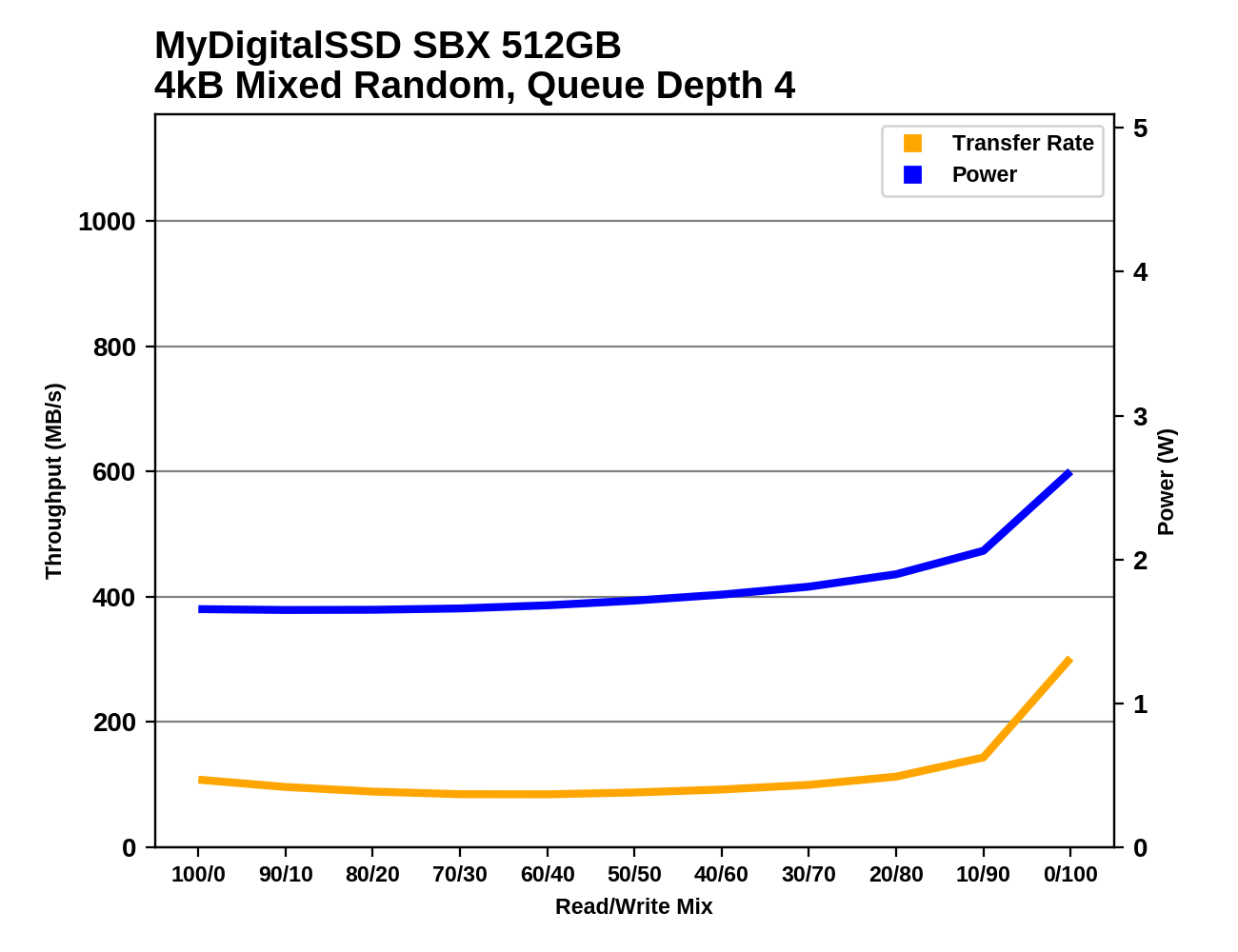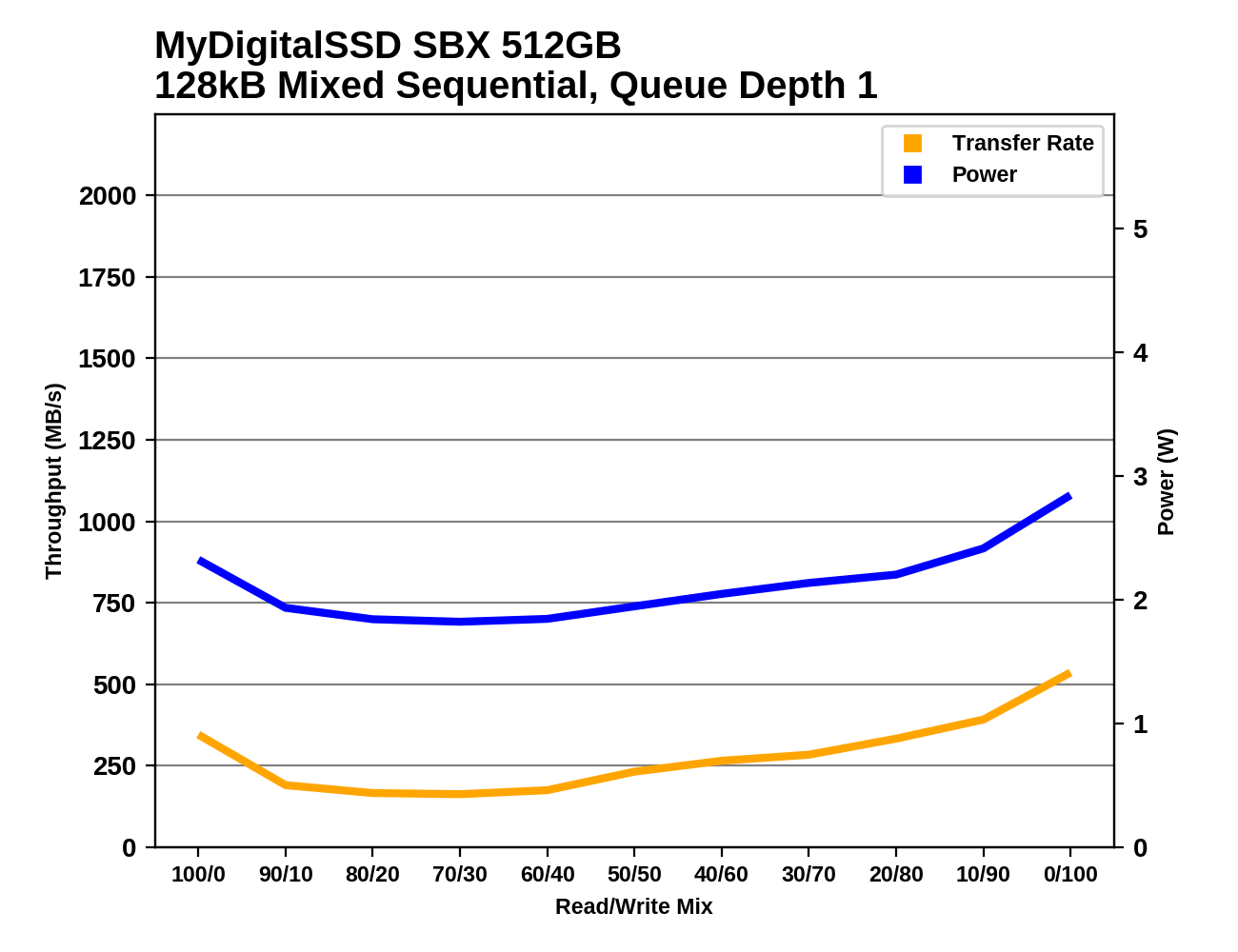The MyDigitalSSD SBX SSD Review: NVMe On The Cheap
by Billy Tallis on May 1, 2018 8:05 AM ESTMixed Random Performance
Our test of mixed random reads and writes covers mixes varying from pure reads to pure writes at 10% increments. Each mix is tested for up to 1 minute or 32GB of data transferred. The test is conducted with a queue depth of 4, and is limited to a 64GB span of the drive. In between each mix, the drive is given idle time of up to one minute so that the overall duty cycle is 50%.

The mixed random I/O performance of the MyDigitalSSD SBX is worse than mainstream SATA drives and all of the NVMe competition. The 512GB SBX even manages to be a bit slower than the 256GB model.
 |
|||||||||
| Power Efficiency in MB/s/W | Average Power in W | ||||||||
Despite poor performance, the larger two capacities of the SBX have reasonable power efficiency on the mixed random I/O test, and the smallest is at least more efficient than the Intel 760p. Looking at power consumption in absolute terms, there is a clear gap between all of the PCIe x4 drives using at least 2.2W and the SBX topping out at 1.8W.
 |
|||||||||
The shape of the performance curves for the SBX on the mixed random I/O test is typical: performance is low and mostly flat or slightly U-shaped for most of the test, then a clear increase in performance as the workload approaches pure random writes. That late boost in performance during the most write-heavy phases of the test is much smaller for the SBX than most high-end drives, and it isn't able to surpass the limits of SATA SSDs.
Mixed Sequential Performance
Our test of mixed sequential reads and writes differs from the mixed random I/O test by performing 128kB sequential accesses rather than 4kB accesses at random locations, and the sequential test is conducted at queue depth 1. The range of mixes tested is the same, and the timing and limits on data transfers are also the same as above.

As with the mixed random I/O test, the performance results for the mixed sequential test put the MyDigitalSSD SBX below the current crop of mainstream SSDs and below all the other NVMe SSDs in this comparison—though the latter result is more or less expected. It's disappointing to see even the Intel 600p outperform the SBX.
 |
|||||||||
| Power Efficiency in MB/s/W | Average Power in W | ||||||||
The power efficiency from the MyDigitalSSD SBX is low, but only the 128GB model stands out as being well below average, and it is at least joined at the bottom of the charts by several Intel drives. As usual, the absolute power draw of the SBX is more typical for a SATA drive than a NVMe drive.
 |
|||||||||
The performance of the MyDigitalSSD SBX drops during the early phases of the test, reaching a minimum with a relatively read-heavy workload before recovering slightly. In the second half of the test as the workload is more write-heavy, the 512GB SBX picks up speed but the 256GB and 128GB models stay at a roughly constant performance level. The 128GB then drops again in the final phase of the test with a pure write workload.










46 Comments
View All Comments
Samus - Tuesday, May 1, 2018 - link
Ditto. I think it'd crazy to use a 2.5" over an M2 if you have the M2 slot available, especially since M2 SATA drives are often cheaper than 2.5" drives (because they are less expensive to manufacture, and the OEM market is larger.)And as far as SATA M2 drives, if you have an M2 slot that supports NVMe, it's hard to justify not using an NVMe SSD when the cost difference is less than 20%...I picked up the WD Black 512GB NVMe drive last week for $150. A decent 540GB class SATA M2 SSD is at least $120.
Death666Angel - Tuesday, May 1, 2018 - link
If every dollar counts and the performance increase is small or won't be used, it's pretty easy to justify getting a SATA M.2 drive instead of an NVME one.Death666Angel - Tuesday, May 1, 2018 - link
Especially since small capacities are likely to be very close in speed, when comparing NMVE and SATA M.2.Byte - Tuesday, May 1, 2018 - link
As someone who does a lot of testing/tweaking, i love the easy formfactor, but hate having to screw and unscrew. We really need a tooless update.MajGenRelativity - Thursday, May 3, 2018 - link
Honestly, I find it about the same amount of time/difficulty to (un)screw an M.2 drive as it is to work with even a toolless 2.5" drive. Unless the M.2 drive is under the GPU, in which case that really annoys meleexgx - Tuesday, May 1, 2018 - link
Still £/$30 more for a customer who is not going to benefit from the nvme ssd (and less money for you)I hardly notice the difference between the sata and nvme ssd my self, main difference is them above 1GB/s speeds but day to day usage I don't really notice much the difference between them unless I am looking for the difference (as long as it's Not a HDD even a slow ssd is many times faster then a hdd)
Do Samsung 850 evo have am issue if they have been left on for to long (like 30 days) as my 850 evo just crap it self out smart fail at Bios and can't read it (only done basic not hirions boot CD yet)
MajGenRelativity - Thursday, May 3, 2018 - link
Actually, I'd technically make a little more money if I sold them an NVMe SSD (my labor cost scales with price of parts), but they wouldn't benefit from it, so I generally don't recommend them. 850 Evo's don't normally have that issue.peevee - Tuesday, May 1, 2018 - link
AT, how about a couple of user-reproducible, real life tests? Compilation of a large software package. Unzipping a large archive. Recoding video. Just to demonstrate the scale of improvement the buyers could actually SEE.SanX - Wednesday, May 2, 2018 - link
Two reasons come instantly. Because only salespeople left in IT. No one even discuss calling lawyers for such confusing people blatant claims like 1600MB/second read speed this product has. And because Windows for example will load something like in 17.6 seconds instead of 17.9 with this drive vs SSD.Funny also is that 2-3 times slower drive which does not deliver at all is just 25-30% cheaper then the leaders.
peevee - Friday, May 4, 2018 - link
This site is often for people for assemble their own PCs and/or choose what to buy for their companies. I'd think a few reproducible, real life tests vs proprietary and compressed tests would show the value of improvements.Maybe it is what AT really is afraid of, because tests show the improvements which do not exist in real life?